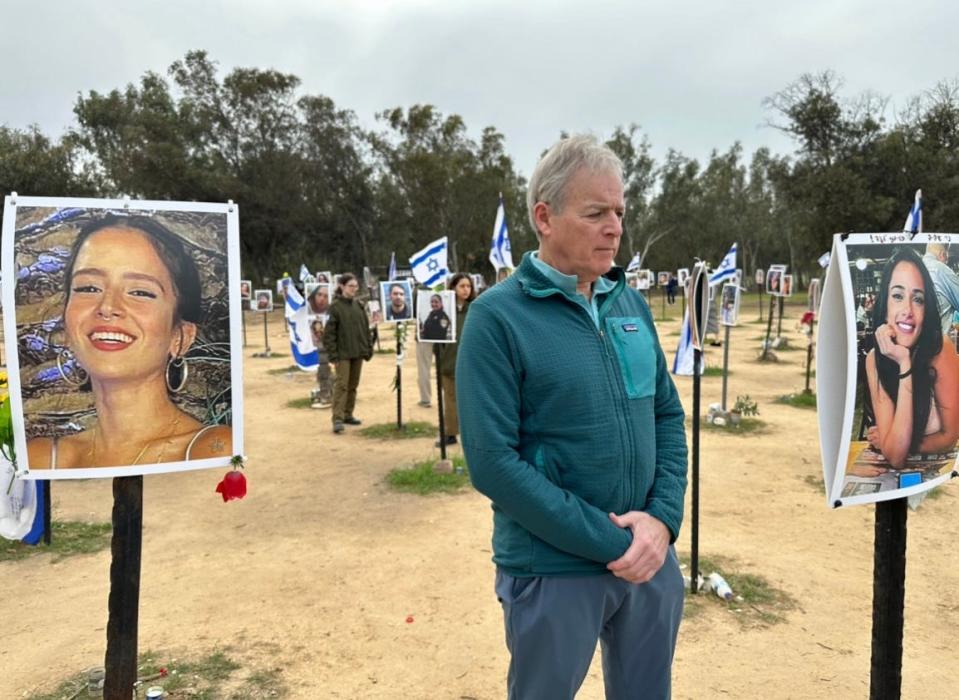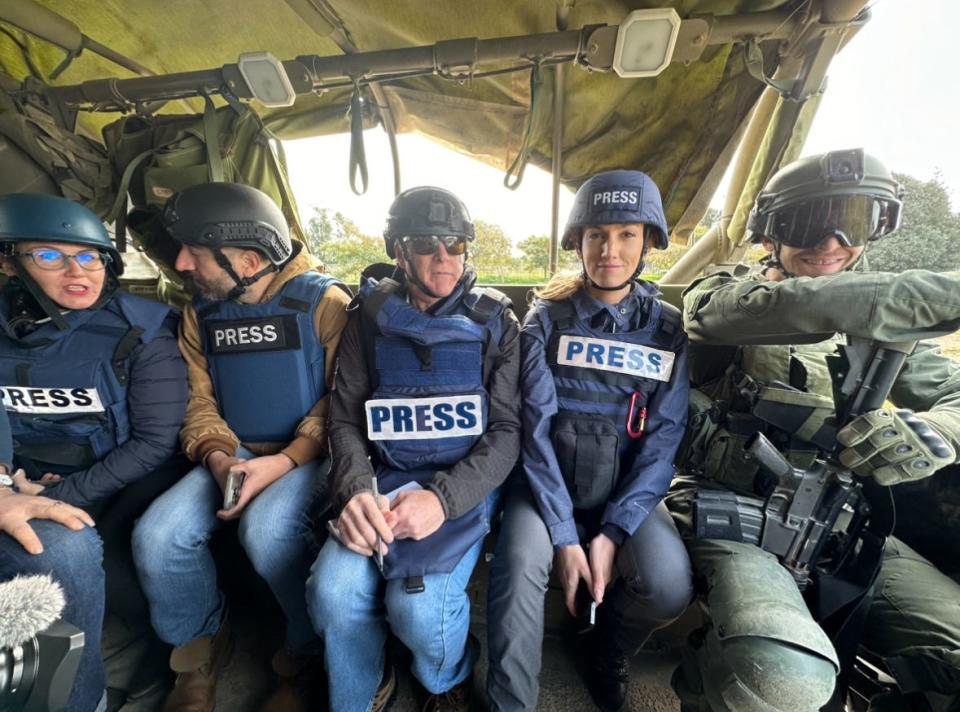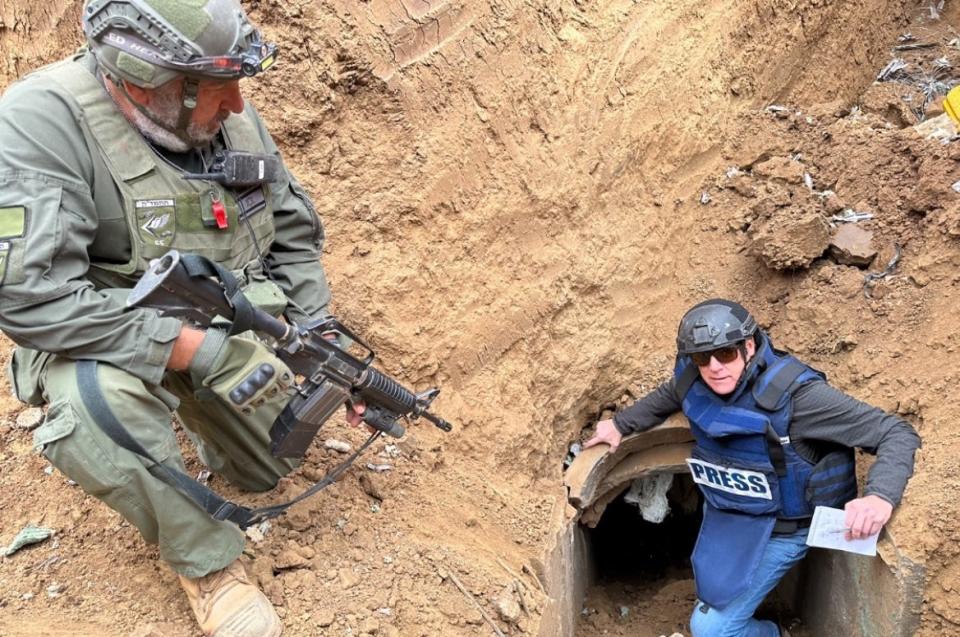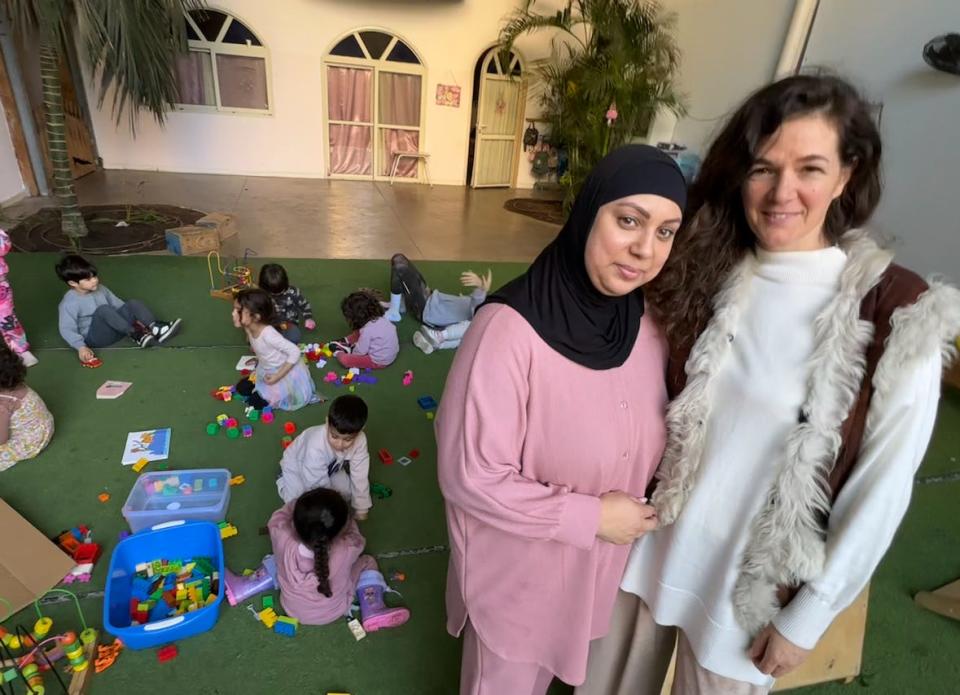Providence Journal columnist Mark Patinkin traveled to Israel and Gaza. Here are his daily dispatches
- Oops!Something went wrong.Please try again later.
Providence Journal columnist Mark Patinkin flew to Israel to see the war, its impact and the effects on the war-torn nations. His daily dispatches provided an unparalleled, first-person look at the conflict.
While there he visited the holy sites of Jerusalem, walked the streets of the West Bank, spoke with survivors of the Nova Music Festival, toured Kibbutz Be'eri (worst hit community of the Oct. 7 attack), discovered the hardships of life in Gaza during Israeli attacks and finally visited Gaza with the Israel Defense Forces.
His trip culminated with a ray of hope on the last day as he visited the Orchard of Abraham’s school for Jewish and Muslim children. There, he discovers the school's mission: tikkun olam. It means repairing the world. Indeed, many parts of this region are broken, but not this school.
More: He's written many columns about Israel. Now Mark Patinkin is going there to tell its stories
During first days in Israel, Mark Patinkin finds beauty clouded by war
We land in Ben Gurion Airport, day one of a trip to experience the Holy Land at war – day 100 since Oct. 7 – except all feels quite ordinary. And then you see them.
An endless row as you walk toward baggage – more than 200 kidnap posters, a thing universal here, except these are a bit different, dozens having either yellow or black slashes with Hebrew lettering.
That first day includes a walk to the central Old City, past the Jaffa Gate that still has bullet scars from the war of 1948. Past the Fortress of David, down the long, narrow pathway through the Christian quarter near the Church of the Holy Sepulchre, where Jesus died and rose. Finally, we emerge in sight of the majestic Western Wall itself, with scores of Orthodox Jews praying at it.
More: The story of Evyatar, the young soldier in Gaza, and his father
Traveling along the West Bank shows the price paid during conflict
We are heading north out of Jerusalem, past towns carved impossibly into harsh limestone hills. The scenery is stunning but the land difficult, so much so that you wonder why tribes have fought over it since the Bible was born here.
An hour-plus into our bus journey north, we come across a long concrete wall, clearly a security structure. Our guide, tells us we’re looking at the West Bank, which explains things, too.
Much of the world has condemned Israel for this war – as terrible as Oct. 7 was, the response in Gaza is said to be too much. But studying a map as we journey, I see us pass a point that explains the obsession here with security – some might say neurosis.
We are at the country’s narrowest neck – an absurd 9 miles wide. Forget the river to the sea. An enemy with the kind of fast vehicles Hamas employed could make it from border to sea in 15 minutes, cutting a nation in half.
More: Traveling along the West Bank shows the price paid during conflict
Finding courage at the site of the Nova Music Festival
Two hours from Jerusalem, I am heading into the Gaza envelope, the swath of towns where it happened. There are two things I want to see this day. First, the site of the Nova music festival, where an astonishing 364 people were slaughtered. Then, Kibbutz Be’eri, the worst hit of such communities with 100 butchered.

We drive a few hundred yards forward and finally are at the heart of the site. It’s marked with an array of posters of the lost on metal posts driven into the hardpacked dirt of a former parking area. The faces on the signs are strikingly attractive, this having happened in their prime. Dozens of visitors walk among them.
More: Finding courage at the site of the Nova music festival
In Hostage Square, they gather and hope for loved ones' return
The image to me is a symbol of Oct. 7 – a young woman named Naama Levy dragged by Hamas men into a car, bleeding between her legs, with her hands zip-tied and her ankles slashed.
It’s why I reached out to speak with her mother, Ayelet, and at first she said yes, hoping each bit of publicity could help. But as the day approached, she apologized; she was emotionally spent and needed time apart.
It happened again with three other families of the kidnapped. I at first got a yes, but, shortly before, they couldn’t do it. The toll of 100 days had drained them.
And so I went to Hostage Square.
Hostage Square: Where they gather and hope for loved ones' return
Getting a tour of paralyzed Brown student's hometown
I’m on the bus to Ramallah, a hub of the West Bank, and as far as I can tell, I’m the only non-Palestinian among 40 or so aboard.
It’s 8 miles from Jerusalem but the trip takes more than an hour, with a checkpoint halfway and all roads but one closed to a metro area of almost 300,000.
That is life on the West Bank.
I’ve come here to see Hisham Awartani’s world. You no doubt have read about Hisham. He grew up in Ramallah and was one of three Palestinian college students shot in Burlington, Vermont, for the crime of speaking Arabic and wearing black and white keffiyehs. He's also a junior at Brown University.
In the West Bank: Getting a tour of paralyzed Brown student's hometown and a feel for Palestinian culture
Making a connection with the people living in Gaza as war rages on
It is perhaps this war’s most challenging story to report – hearing what Gaza is like from the people inside it.
International journalists aren’t getting in. The best route would be with humanitarian groups, but they’re unable to bring us. The only option is remote so I began to gather phone numbers.

I kept making calls for days and at last managed to connect live with someone inside Gaza. He was a likely candidate to be reached, since his job is to be available. His name is Hisham Mhanna, a young communications guy for the International Committee of the Red Cross.
Lives destroyed: Making a connection with the people living in Gaza as war rages on
Faces of the dead a haunting presence at Kibbutz Be'eri
The first thing you see as you enter Kibbutz Be’eri are the burned homes, but soon you notice something more unsettling.
Hamas wasn’t satisfied to just set fire. What wasn’t burned was smashed, leaving hardscaped patios in jagged pieces. They did to the houses what they did to the people – first they murdered, then they mutilated.
It’s one reason many of us have come. As with all of history’s massacres, there is only one thing you can do for the dead, and that is to bear witness.
Read and bear witness: Faces of the dead a haunting presence at Kibbutz Be'eri
Trip to Bethlehem reveals Palestinian warmth amid loss
There is a tendency to think of Bethlehem as part of Israel – some picture it near the Western Wall, but it’s not like that. It’s beyond the border, an all-Palestinian town with three refugee camps, and Jewish settlements encroaching.
To get there, you take a cab out of Jerusalem for a half-hour, then walk through a dark boundary tunnel.
The moment I emerge, I’m surrounded by Palestinian cab drivers. They wonder why I’m here – tourists haven’t come to Bethlehem since Oct. 7.
An American journalist, I tell them.
At that, they want to talk. Why, asks one, is my government funding bombs killing babies in Gaza?
Its DNA is tolerance: Trip to Bethlehem reveals Palestinian warmth amid loss
In a Tel Aviv hospital, Mark Patinkin learns the stories behind the scars
When the weather is good, it's hard to count the wounded soldiers who flood Tel Aviv’s Sheba Medical Center's patio. They gather in wheelchairs, limping with crutches and wrapped in bandages. Almost every day helicopters bring more.
When I first walked down the busy corridor to the patio, something was off that I couldn’t put a finger on. Then I realized it. It’s not natural to see so many young men in their prime in a hospital. Here are their stories.
'It shocks you': Tel Aviv’s Sheba Medical Center displays the sacrifices of war
Headed for the front lines: Patinkin gets clearance to ride with IDF into Gaza
For the first day and a half, I was here with a Rhode Island mission, but the two weeks since have been on my own.
Some of those nights have been lonely, in part because I was sending back live dispatches every day.
But now, with only days left here, a WhatsApp text has just arrived.

It’s from an IDF media contact.
A journalist’s trip into Gaza is on for the next morning, and I’ve been granted a space. She gives me the location of a deployment spot to meet just outside the fence along the strip, two hours from Jerusalem.
Overcoming long odds: Mark Patinkin chronicles his unprecedented trip to Israel, embedded with Gaza and IDF in sight
A post-apocalyptic scene as IDF embed travels through path of war
Among those gathered for the embed are correspondents with CBS and Fox News, as well as counterparts from other countries. Our guide asks us to turn off our phone locations – no one wants a surprise.
Suddenly, we turn left through a break in the fence.
Lt. Col. Anshi would soon tell us it’s one of the very openings blown apart by Hamas on their way in. You can’t help but note the irony that Israel is now using it.
At that, there’s an enormous boom – a helicopter-fired missile, he says. The front line, explains Anshi, is less than a mile away in dense Khan Yunis. An hour from now, I would hear a more unsettling sound of war.
“Welcome to Gaza,” says Anshi.
Inside Gaza: A post-apocalyptic scene as IDF embed travels through path of war
A glimpse of hope comes from the education of youth
As this journey to Israel, the West Bank and Gaza reaches its end, I’ve learned a difficult truth.
The divide between Palestinian and Jew is perhaps as wide as it’s ever been.
Many Israelis who once were for peace doubt after Oct. 7 that they have a partner for it.
And Palestinian anger over Gaza’s ruins has hardened hearts.
Which is why in this final column, I offer a glimpse of hope: a rare school where both Jewish and Arab children share space, and life, and – just maybe – sow seeds of more of that.

More: Mark Patinkin in Israel: A glimpse of hope comes from the education of youth
Walk through Jerusalem reminder of why Arab and Jew hold onto it so
One last time before I leave Israel, I am drawn to the Old City, to feel its spirit and hear its voices during this difficult moment and talk with the people of the city.
It’s where their prophets walked, their ancestors died, and today their brethren are dying yet again.
And you realize as you leave how much this explains.
After so much sacrifice, millennia of it, how do Arab and Jew let go of such a place?
How?
More: Mark Patinkin in Israel: Walk through Jerusalem reminder of why Arab and Jew hold onto it so
Mark Patinkin traveled to Israel personally and was not sponsored by or affiliated with any organization. He reported firsthand from the region as he has done for the last four decades through his award-winning journalism. He can be reached at mpatinki@providencejournal.com.
This article originally appeared on The Providence Journal: A collection of daily dispatches from the Israel-Hamas war

